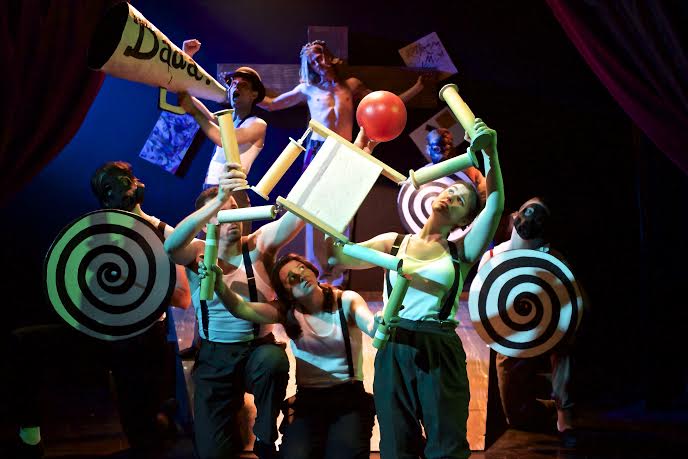 It was 100 years ago this year when Hugo Ball chose a nonsense word to label the anti-art movement of World War I – dada.
It was 100 years ago this year when Hugo Ball chose a nonsense word to label the anti-art movement of World War I – dada.
At the Cabaret Voltaire, he gathered with other artists, poets, and revolutionaries to declare this topsy-turvy movement of revolt and the revolting.
In celebrating the life of Ball, D.C.’s innovative Pointless Theatre could have gone full out dada with crazed, erratic, exuberant and possibly pointless performance that didn’t bother adhering to any bourgeois structures of theater or art.
And while its “Hugo Ball: a Dada puppet AdveNTuRe!!/?1!!??” does begin with random vocal exercises, word associations, visual gags behind the curtain as the audience takes its seat (and ends that way too), the play by David Lloyd Olson actually follows closely the life of the German born artist and poet, from his birth and childhood to his meeting of fellow poet and future wife Emmy Hennings in Switzerland, to the creation of dadaism at the Cabaret Voltaire in Zurich with an array of like minded figures of note, from Tristan Tzara to Jean Arp.
The central joke of the lightly biographical play, though, is that Ball himself is represented by a ball – a red rubber ball that serves fine as his baby self and later becomes his blank face to a puppet that is otherwise made of a square and linked cylinders.
It’s to the credit of the accompanying and revolving puppeteers that they bring so much life to Ball, in part through their own facial expressions and exhortations, but also through the dramatic positioning of the figure.
Likewise, Emmy is a puppet as well, whose legs become that of the female puppeteers in fishnets.
The large and versatile cast of 10 – though I counted 11 at one point – promised outrageous vulgarity, nudity and sex in the play, but delivered little of that other than some course language. They all largely stayed inside their similar costumes (by Lee Gerstenhaber) – white T-shirt, grey pants and suspenders to tell the fast moving tale.
While there are indeed moments of chaos and yelling in the piece (and yes, one deafening gunshot), it’s much more structured and easy to follow than expected, in part because of its titled scenes of his life presented on cards as if were a vaudeville act.
Director Matt Reckeweg knows something about visual punch and working with Patti Kalil’s set, mask and puppet design presents the kind of authentic expressionist zing the work requires. Much like their zig-zaggy work recreating “Dr. Caligari,” there is reverence to the anarchic period and some historical accuracy as well – the stylized bishop costume Ball wears near the end is very like the styling of his actual costume.
Built from a 2011 production staged at the Capital Fringe Festival, where it won best experimental show, the expanded production includes a dizzying romp through Greek tragedy, Wagnerian opera, Shakespeare and the shattering of culture during World War II that led to dada.
Aaron Bliden is composer and music director. And while there isn’t really room for a lot of dance, there is a fight director listed in Lex Davis.
The troupe prefers to be listed as just the ensemble, but it’s the least we can do to list their names and salute the many frenzied contributions each of them bring to the striking evening – the least being the ad libbed humor behind the curtain: Frank Cevarich, Kyra Corradin, Madeline Key, Sadie Leigh, Devin Mahoney, Hilary Morrow, Stacy Musselman, Matthew Sparacino, Scott Whalen and Sarah Wilby.
“Hugo Ball: a Dada puppet AdveNTuRe!!/?1!!??” continues though May 14 at Capital Fringe’s Trinidad Theatre at the Logan Fringe Arts Space, Washington, D.C.